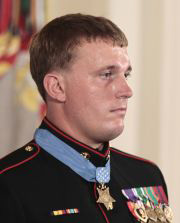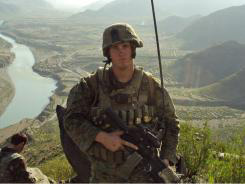redo Jump to...
print Print...

Sept. 15: Medal of Honor recipient, former Marine Corps Cpl. Dakota Meyer, 23, from Greensburg, Ky., during a ceremony in the East Room of the White House in Washington.
(by Julie Pace, YahooNews.com) WASHINGTON (AP) — Defying orders and tempting fate, Marine corporal Dakota Meyer charged five times in a Humvee into heavy gunfire in the darkness of an Afghanistan valley to rescue comrades under attack from Taliban insurgents.
On Thursday, Meyer was presented with the Medal of Honor, the nation’s highest military award, by President Barack Obama.
Meyer’s courage during the six-hour ambush and firefight saved the lives of 36 people, both Americans and Afghans. He killed at least eight Taliban insurgents. Firing from a gun turret on top of the Humvee driven by a fellow Marine, he provided cover for his team, allowing many to escape likely death.
He was defying orders from his commanders, who told him to stay back. The kill zone, they said, was too dangerous. But the young corporal, just 21 years old at the time, knew his friends were trapped that early morning in September 2009.
“In Sgt. Dakota Meyer, we see the best of a generation that has served with distinction through a decade of war,” Obama said during a ceremony in the East Room of the White House.
Meyer, later promoted to sergeant and now out of the Marines, is the third living recipient and the first Marine to be awarded the Medal of Honor for actions in Iraq or Afghanistan.
The modest, soft-spoken 23-year-old now lives in his home state of Kentucky, working construction in the tiny town of Greensburg. [He is in the Marine reserves.]
Obama praised Meyer for his humility and work ethic. When the White House tried to reach him in the middle of a workday to tell him his medal had been approved, he worried about whether he could take a call while on the job. So the White House arranged for the president to call during Meyer’s lunch break. With a smile, Obama thanked him for taking the call.
On the eve of the Medal of Honor ceremony, Obama and Meyer met in person, chatting on a patio near the White House Rose Garden, over a beer.
Despite Meyer’s heroism, four Americans died in the ambush: 1st Lt. Michael Johnson, a 25-year-old from Virginia Beach; Staff Sgt. Aaron Kenefick, 30, of Roswell, Ga.; Corpsman James Layton, 22, of Riverbank, Calif.; and Edwin Wayne Johnson Jr., a 31-year-old gunnery sergeant from Columbus, Ga. A fifth man, Army Sgt. Kenneth W. Westbrook, 41, of Shiprock, N.M., later died from his wounds.
Meyer says he has struggled with the national attention, with being recognized for the worst day of his life. He requested that memorial services for those who died that day be held in their hometowns at the same time he received the Medal of Honor.
The president assured Meyer that he had let no one down.
“Dakota, I know you’ve grappled with the grief of that day, that you said your efforts were somehow a failure because your teammates didn’t come home,” the president said. “But as your commander in chief and on behalf of everyone here today and all Americans, I want you to know it’s quite the opposite.” ……

Marine Cpl. Dakota Meyer was deployed in support of Operation Enduring Freedom in Afghanistan's Kunar province.
Meyer was part of a security team supporting a patrol moving into a village in the Ganjgal Valley on Sept. 8, 2009. Suddenly, the lights in a nearby village went out and gunfire erupted. About 50 Taliban insurgents on mountainsides and in the village had ambushed the patrol.
As the forward team took fire and called for air support that wasn’t coming, Meyer begged his command to let him head into the incoming fire to help.
Four times he was denied before he and another Marine, Staff Sgt. Juan Rodriguez-Chavez, jumped into the Humvee and headed into the fray. For his valor, Rodriguez-Chavez, a 34-year-old who hailed originally from Acuna, Mexico, would be awarded the Navy Cross.
With Meyer manning the Humvee’s gun turret, the two drew heavy fire. But they began evacuating wounded Marines and American and Afghan soldiers to a safe point. Meyer made five trips into the kill zone.
During that fifth trip into the kill zone, a helicopter arrived at last to provide overhead support. Troops aboard the chopper told Meyer they had spotted what appeared to be four bodies. Meyer knew those were his friends.
“It might sound crazy, but it was just, you don’t really think about it, you don’t comprehend it, you don’t really comprehend what you did until looking back on it,” Meyer said.
Wounded and tired, Meyer left the relative safety of the Humvee and ran out on foot.
Ducking around buildings to avoid gunfire, he reached the bodies of his fallen comrades.
Meyer and two other troops dodged bullets and rocket-propelled grenades to pull the bodies out of a ditch where the men had died while trying to take cover.
Associated Press writers Dylan Lovan in Louisville, Ky., and Robert Burns in Washington contributed to this report.
Copyright ©2011 Associated Press. All rights reserved. Reprinted here for educational purposes only. The information contained in this AP news report may not be published, broadcast, rewritten, or redistributed without the prior written authority of the Associated Press. Visit news.yahoo.com/defying-orders-hero-marine-saved-other-troops-215814570.html for the original post.
Questions
1. Who is Dakota Meyer?
2. What is the Medal of Honor? Be specific. (see “Background” below the questions for details)
3. Why has Dakota Meyer been awarded the Medal of Honor? (What did he do?) Be specific.
4. What request did Sgt. Meyer make when he was told he would be receiving the Medal of Honor?
5. Name the five American troops who died in the ambush in Ganjal Valley, Afghanistan.
6. a) Think about how much you know about each of the following people. Why are they famous?
Lady Gaga
Justin Bieber
Katy Perry
Casey Anthony
Chace Crawford
Paul “Pauly D” Del Vecchio
Simon Cowell
Charlie Sheen
b) How many heroes of the Iraq or Afghanistan Wars can you name? Why do you think this is so?
c) Why is it important for Americans to know the stories of Dakota Meyer and other soldiers like him?
Background
THE MEDAL OF HONOR:
- The Medal of Honor is the highest military decoration awarded by the United States government.
- It is bestowed by the President in the name of Congress on members of the United States Armed Forces who distinguish themselves through “conspicuous gallantry and intrepidity at the risk of his or her life above and beyond the call of duty while engaged in an action against an enemy of the United States.”
- Due to the nature of its criteria, it is often awarded posthumously (more than half have been since 1941).
- Members of all branches of the armed forces are eligible to receive the medal, and there are three versions (one for the Army, one for the Air Force, and one for the Navy, Marine Corps and Coast Guard).
- The Medal of Honor is bestowed upon an individual by the passing of a Joint Resolution in the Congress; and is then personally presented to the recipient or, in the case of posthumous awards, to next of kin, by the President of the United States, on behalf of the Congress, representing and recognizing the gratitude of the American people as a whole.
- Due to its honored status, the medal is afforded special protection under U.S. law.
- As the award citation includes the phrase “in the name of Congress”, it is sometimes erroneously called the Congressional Medal of Honor; however, the official title is simply the Medal of Honor. (from wikipedia)
Resources
Watch a video of Dakota Meyer in his own words:
- Read about the Medal of Honor at history.army.mil/moh.html.
- Read about Navy SEAL Lt. Michael Murphy (who received the Medal of Honor posthumously in 2007) at studentnewsdaily.com/daily-news-article/honor_for_a_fallen_hero.
- Read about Navy SEAL Petty Officer 2nd Class Michael Monsoor (who received the Medal of Honor posthumously in 2008) at navy.mil/moh/monsoor.
- For a list of the 10 Medal of Honor recipients from the Iraq and Afghanistan Wars, go to en.wikipedia.org/wiki/List_of_Medal_of_Honor_recipients#War_in_Afghanistan.
Daily “Answers” emails are provided for Daily News Articles, Tuesday’s World Events and Friday’s News Quiz.



